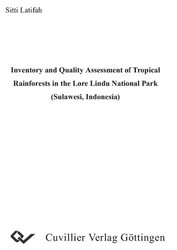| Areas | |
|---|---|
| Serie de libros (96) |
1379
|
| Nachhaltigkeit |
3
|
| Gesundheitswesen |
1
|
| Letra |
2367
|
| Ciencias Naturales |
5407
|
| Matemática | 229 |
| Informática | 319 |
| Física | 980 |
| Química | 1364 |
| Geociencias | 131 |
| Medicina humana | 243 |
| Estomatología | 10 |
| Veterinaria | 108 |
| Farmacia | 147 |
| Biología | 835 |
| Bioquímica, biología molecular, tecnología genética | 121 |
| Biofísica | 25 |
| Nutrición | 45 |
| Agricultura | 1004 |
| Silvicultura | 201 |
| Horticultura | 20 |
| Ecología y conservación de la tierra | 148 |
| Ciencias Ingeniería |
1793
|
| General |
98
|
|
Leitlinien Unfallchirurgie
5. Auflage bestellen |
|
Erweiterte Suche
Inventory and Quality Assessment of Tropical Rainforests in the Lore Lindu National Park (Sulawesi, Indonesia) (Tienda española)
Sitti Latifah (Autor)Previo
Indice, Datei (7,1 KB)
Lectura de prueba, Datei (23 KB)
With Indonesia’s approximately 109 million hectares of forested land, the forestry and the forest industry play an important role in the country’s economy. Timber is still the dominant forest product in Indonesia, and its utilization is the basis of many industries. In 1997, the forestry and wood processing sectors accounted for 3.9 % of the GDP, and exports of plywood, pulp and paper were valued at 5.5 billion US$. This amount was nearly half the value of oil and gas exports, and represented nearly 10% of total export earnings. Despite the importance of the forestry sector to the country’s economy, timber utilization in natural tropical forests is for the most part, poorly planned, without consideration for the soil and the remaining stand, and also for economical and ecological sustainability. In addition, the use of the timber is usually limited to the best part of the trees. More than one third of the felled trees remain in the forest, although in Indonesia the raw material of wood exists abundantly. Furthermore, due to the concession system implemented in Indonesia, an area of 11.7 million hectares has already been degraded.
| ISBN-10 (Impresion) | 3865373399 |
| ISBN-13 (Impresion) | 9783865373397 |
| ISBN-13 (E-Book) | 9783736913394 |
| Formato | A5 |
| Idioma | Alemán |
| Numero de paginas | 180 |
| Edicion | 1 Aufl. |
| Volumen | 0 |
| Lugar de publicacion | Göttingen |
| Lugar de la disertacion | Göttingen |
| Fecha de publicacion | 24.01.2005 |
| Clasificacion simple | Tesis doctoral |
| Area |
Silvicultura
|








